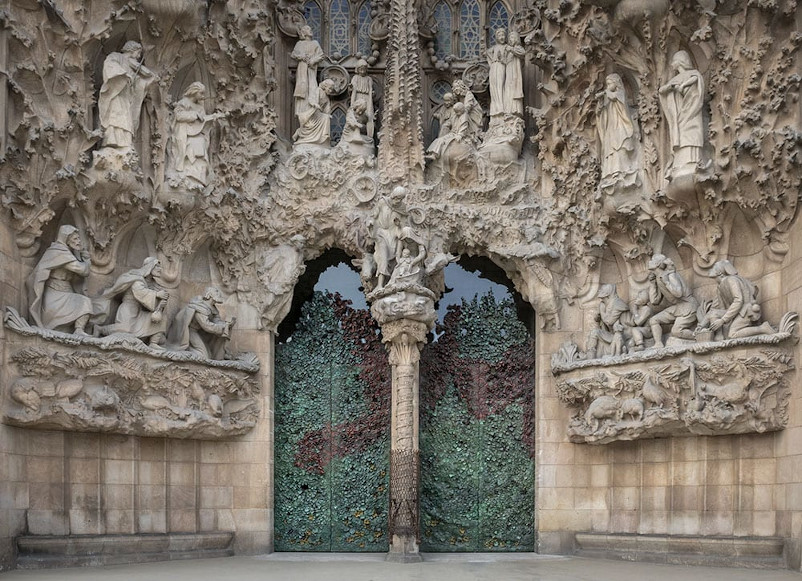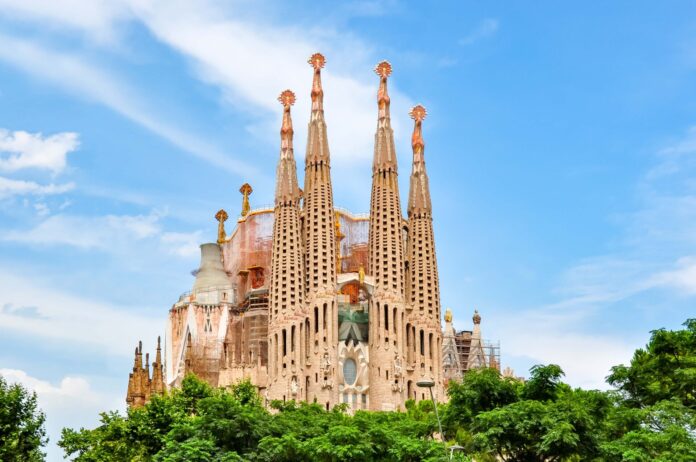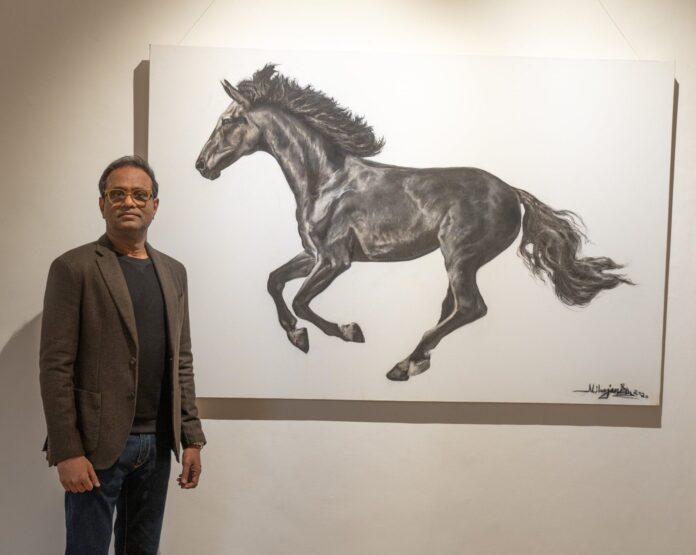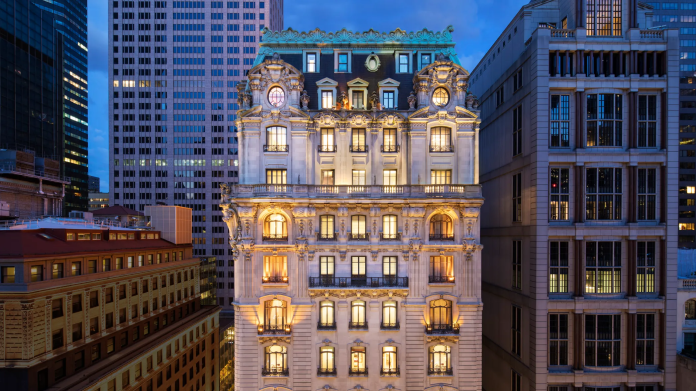In its century-long existence, the Sagrada Família—short for Basílica i Temple Expiatori de la Sagrada Família—has been considered the epitome of the amalgamation of art and architecture. Designed by Catalan architect Antoni Gaudí, its architecture blends in many inspirations, including the Spanish Late Gothic, Catalan Modernism, and Art Nouveau elements—deeply yet delicately imbibing Christian themes throughout. Gaudí deeply believed it would become a Spanish icon, “…people will come from all over to see what we have done”. Nothing conveys that sentiment of subtle sophistication better than art critic Rainer Zerbst’s comment on the Basilica: “It is probably impossible to find a church building anything like it in the entire history of art.”
Considered a masterful artwork, it melds different arts. Inspired by nature’s bounty, the architecture abounds in the inculcation of nature’s elements. Crafted in the style of Gothic Naturalism, both flora and fauna feed into Sagrada Familia’s architectural design. For instance, turtles, seashells, fruit, trees, and other elements are represented. This particular love of nature evoked by Gaudi isn’t a one-off. Gaudi’s Casa Milà and Parc Guell are perfect examples to represent that—while the former has stem-like guardrails adorning it, the latter takes its inspiration from the waves from the seas and oceans.
?_a=BAVAEyBy0)
History of Sagrada Familia
It is inspired by Spaniard José María Bocabella’s—a pioneer of Asociación Espiritual de Devotos de San José (Spiritual Association of Devotees of St. Joseph)—visit to a basilica at Loreto in the Vatican. Initially, architect Francisco de Paula del Villar was commissioned to undertake the work. As is commonly observed in the Gothic tradition, especially in Romanesque Christian churches, Villar inducted an apse crypt in the church. In 1883, at Villar’s resignation, the apse crypt was wholly assembled—in the Gothic revival manner.
Post Villar’s resignation, Antoni Gaudí was appointed, primarily for creating blueprints for the architectural design—during which he also redid the construction of Villar’s apse crypt. Gaudi, whose tenure stretched till 1926, proceeded with the construction at a snail’s pace. When asked the reason for this mediocre rate of progression, Gaudi stated: “My client is not in a hurry.” His reference to the client was the Almighty God. As a result, at Gaudi’s death in 1926—despite thirty years of Gaudi’s efforts, only a fourth of the church was constructed.
After that, several architects—Domènec Sugrañes i Gras, Francesc Quintana, Isidre Puig Boada, Lluís Bonet i Garí and Francesc Cardoner—followed in Gaudi’s path. Since the start of its construction, it often had to be halted, given the socio-political instability that punctuated Spain. In the twenty-first century, much of the work has centred on the Glory facade. Much of this has relied on new-age technology to carry forth the work.

Interior of Sagrada Familia
Planned in the style of a Latin cross, the interior unfolds with an ethereal resplendence. Imbibing Gaudi’s vision, with Sagrada Familia’s central nave vaults reaching forty-five metres in height, complemented by side nave vaults, reaching thirty metres each. Accompanying these soaring columns that seem to reach into heaven—decked with their intricate carvings. The windows of the Basilica stand apart with their kaleidoscopic combination of colours. Elements complement and contrast each other, making for an artistic harmony that is unmatched and unparalleled.
Exterior of Sagrada Familia
The Sagrada Familia was built to reflect Spanish Late Gothic sensibilities, but with time, it also imbibed elements from Catalan Modernism and Art Nouveau. Built-in a vein similar to many Catalan cathedrals, the Basilica is marked by the complexity of the constitution. It is packed with Christian themes, witnessed as liturgy words carved into Basillia’s interior and exterior. For instance, the towers are redolent of words such as “Hosanna”, “Excelsis”, and “Sanctus”—all Christian motifs.
But what makes it unique, even unusual, is that the cathedral has no straight line in its architecture. And this feature aligned with Gaudi’s intention. Inspired by the natural world, Guadi believed that there were no straight lines in nature, and therefore, a dedication to its creator would only be well-suited if it reflected this aspect.

The most notable features of the exterior of the Basilica are its richly, resplendently crafted spires and facades.
Spires: Embellishing the Barcelona skyline, the Sagrada Familia was intended to have eighteen spires—each corresponding, in varying heights, to the Twelve Apostles, the four Evangelists, the Virgin Mary and, tallest of all, Jesus Christ.
Facades: The church’s exterior is dominated by three graceful, glorious facades: firstly, there is the Nativity facade facing eastwards. Secondly, the Passion facade facing westwards and, lastly, the Glory facade facing southwards.
Nativity Facade: Reflective of the birth of Christ, it is redolent with life motifs—taking inspiration from the Earth’s natural elements. For instance, the Tree of Life rises above the door of Jesus at the entrance of Charity—with Christian theological ornamentation.
Passion Facade: Reflective of the Passion of Christ, the suffering of Jesus during the crucifixion, and the gravity of man’s sins. As a result, this facade is largely austere, with bare stones used to create this element of the cathedral.
Glory Facade: Though the other two facades overflow with Christian theological connotations, this facade was meant to be the epitome of the art and architecture of the cathedral. Evocative of the Celestial Glory of Jesus, it chronicles the crisscrossing path of life that ultimately leads to God: Death, Final Judgment, and Heaven or Hell—depending on man’s action during time on Earth. Notably, this facade will also reference the seven heavenly virtues and seven deadly sins—that are judged in the afterlife, paving the way for heaven or hell.






